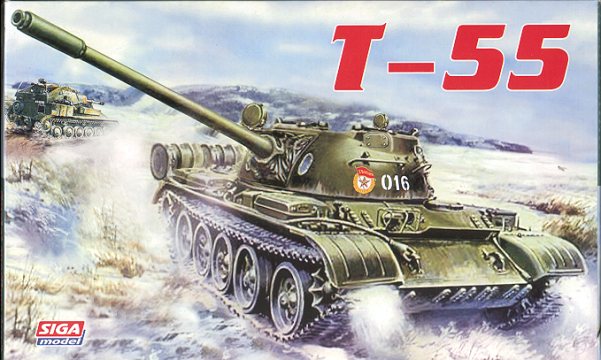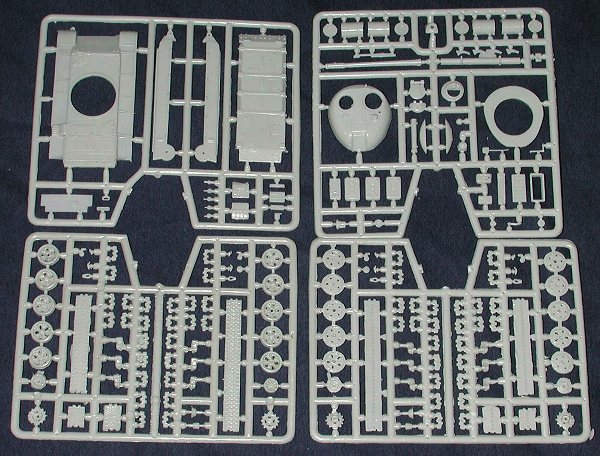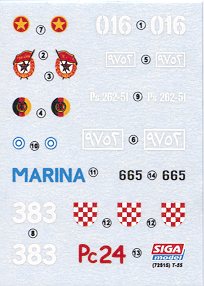
|
KIT: |
SIGA 1/72 T-55 |
|
KIT # |
52315 |
|
PRICE: |
$ |
|
DECALS: |
7 versions |
|
REVIEWER: |
|
|
NOTES: |

|
HISTORY |
I know darn little about armor in general and even less about Soviet armor. This is from the US Army Field Manual 100-2-3 printed in 1991:
The T-55 medium tank has a fully tracked, five-road-wheeled chassis. This chassis has a space between the first and second road wheels and no return rollers. The T-55 has a low-silhouetted hull with a dome-shaped turret mounted over the third road wheel. The 100-mm rifle-bore main gun has a bore evacuator at the muzzle. The T-55 also mounts a 7.62-mm coaxial machine gun; the later T-55A version lacks the bow machine gun.
The T-55 differs from the older T-54 models because it lacks the right-hand cupola and the turret dome ventilator, which is located in front of the cupola on the T-54. Most T-55s also lack the turret-mounted 12.7-mm AA machine gun of the T-54. All T-55s mount an infrared gunner's searchlight above and to the right of the main gun. This searchlight, however, is not a distinguishing feature since it has been retrofitted to many T-54 and T-54A tanks.

The T-55 combines a high-velocity gun with a highly mobile chassis, a low silhouette, and exceptional long-range endurance. Improvements over the T-54 include a larger V-12 water-cooled diesel engine with 580 rather than 520 horsepower, and an increased cruising range of 500 rather 400 kilometers (600 kilometers with auxiliary tanks). The increased cruising range can go up to 715 kilometers with two 200-liter auxiliary fuel tanks which can be carried on the rear. The T-55 has two-plane stabilization of the main gun rather than vertical stabilization only. It also has a basic load for the main gun of 43 rather than 34 rounds.
The T-55 can ford depths of 1.4 meters without preparation. It has snorkel equipment which enables it to cross depths of up to 5.5 meters at a speed of 2 kilometers per hour. This equipment takes about 30 minutes of preparation, but can be jettisoned immediately on leaving the water. All T-55s have the PAZ radiation detection system; the T-55A also has an anti-radiation liner. The Soviets may have retrofitted some T-55s with a full NBC collective protection system (air filtration and overpressure). Injecting vaporized diesel fuel into the exhaust system can generate a dense smoke screen.
The half-egg shaped turret of the T-55 has good ballistic qualities; however, it created cramped working conditions for the crew. This results in a slow rate of fire. Its silhouette is one meter lower than the M-60's. This advantage is counterbalanced by its poor armor protection, which is thin by Western standards. Its gun control equipment is also crude. It shares the disadvantage that most Soviet tanks have: a limited ability to depress the main gun. This hinders its ability to fire effectively from defilade, forcing it to expose itself to engage targets. Ammunition and fuel storage positions are vulnerable. The lack of a turret basket presents loading difficulties, and there is limited ready ammunition. The driver, commander, and gunner all sit in a line.
The T-55 is not airtight. The filtration system protects the crew from radioactive dust. However, they must wear individual protective masks and clothing to guard against chemical and biological agents. The tank must thus pass through contaminated areas rapidly and the crew must decontaminate it before it is fully operational.
The tank can be made watertight for fording water obstacles up to 1.4 meters deep (or 5.5 with snorkel). However, it takes one half-hour to prepare a medium tank unit for a snorkeling operation. Entrance and exit points may also need preparation.
|
THE KIT |

As with other SIGA armor kits, this one is manufactured by another of a closely-knit group of model makers and only packaged by SIGA. There are four sprues of medium grey plastic. The shiny plastic seems harder than the softer white plastic used on some of the other SIGA-packaged armor kits.
The kit is probably made in a low pressure mold as is evident by many of the
'short run traits' that it shows. Specifically, the relatively large parts
attachment points, the flash that is on a number of the parts and the somewhat
'softness' of the detailing. I also found sink marks on a few of the thicker
pieces, the most difficult to fill which are those on the upper hull piece. I
also noted that there were a number of 'stress fractures' in some of the larger
parts. These are fine surface lines  that
you can feel with your finger nail and will have to be filled as well. They are
most apparent on the larger, flat pieces.
that
you can feel with your finger nail and will have to be filled as well. They are
most apparent on the larger, flat pieces.
One thing about armor kits is that there are a ton of parts. 183 of them in this particular kit. Most of those are dedicated to the road wheels and the tracks. Some of the smaller parts, such as turret hand-holds will have to be constructed from wire, but this is quite typical of these kinds of kits.
Instructions are quite good and in the usual SIGA style with a sequence of main assembly in the first 2/3rds of the sheet and any subassemblies shown in the other third of the sheet. It works quite well and is a logical sequence. Any color information needed for other than the overall model is given where it is appropriate. The T-55 was used by a substantial number of military forces and that is shown in the markings options. No less than seven options are provided, offering a nice range of camouflage schemes. You can choose from T-55s from the Soviet Union, Finnish Army, East German Army, Syria, Peru, Croatia and North Vietnam. There is a small but well printed decal sheet provided. If it is anything like that for the AM-1 Mauler, it will be thin, stick well and be very opaque. In other words, about perfect!
|
CONCLUSIONS |
SIGA recommends this kit for ages 10 and older. I'd have to echo that suggestion and also state that this is not a kit for the beginner. The number of small parts and short run quality of the kit are such that I'd say you need to have some experience with short run kits to be able to do a credible job on this one. However, it has lots of possibilities and is a very interesting subject. There will be a full build review done on this one so stay tuned.
Thanks to SIGA for providing the review sample. You can find SIGA kits at most well-stocked hobby shops or on-line merchants.
If you would like your product reviewed fairly and quickly where it will be seen by well over 150,000 visitors a month, please contact me or see other details in the Note to Contributors.